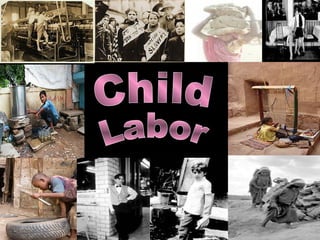
Presentación1
- 3. Child labor is work that harms children or keeps them from attending school. Around the world and in the U. S., growing gaps between rich and poor in recent decades have forced millions of young children out of school and into work.
- 5. Violates a nation’s minimum age laws. Threatens children’s physical, mental, or emotional well-being. Involves intolerable abuse, such as child slavery, child trafficking, debt bondage, forced labor, or illicit activities. Prevents children from going to school. Uses children to undermine labor standards.
- 7. Of an estimated 215 million child laborers around the globe: 114 million (53%) are in Asia and the Pacific. 14 million (7%) live in Latin America. 65 million (30%) live in sub-Saharan Africa. 22 million (10%) live in other places.
- 8. ● Agriculture ● Manufacturing ● Mining and Quarrying ● Hotel, restaurant and reital
- 9. An estimated 60% of child labor occurs in agriculture, fishing, hunting, and forestry. Children have been found harvesting: ● Bananas in Ecuador ● Cotton in Egypt and Benin ● Cut flowers in Colombia oranges in Brazil ● Cocoa in the Ivory Coast tea in Argentina ● Bangladesh fruits and vegetables in the U.S.
- 10. About 14 million children are estimated to be directly involved in manufacturing goods, including: ● Carpets from India, Pakistan, Egypt ● Clothing sewn in Bangladesh; footwear made in India and the Philippines ● Soccer balls sewn in Pakistan ● Glass and bricks made in India ● Fireworks made in China, the Dominican Republic, El Salvador, Guatemala, India, and Peru ● Surgical instruments made in Pakistan
- 11. Child laborers suffer extremely high illness and injury rates in underground mines, opencast mines, and quarries. Children as young as 6 or 7 years old break up rocks, and wash, sieve, and carry ore. Nine-year-olds work underground setting explosives and carrying loads. Children work in a range of mining operations, including: ● Gold in Colombia ● Charcoal in Brazil and El Salvador ● Chrome in Zimbabwe ● Diamonds in Cote d’Ivoire ● Emeralds in Colombia ● Coal in Mongolia
- 12. Some of the work of young people in this sector is considered legitimate, but there are indications of considerable abuse. Low pay is the norm, and in some tourist areas, children’s work in hotels and restaurants is linked to prostitution. In at least one example, child hotel workers received such low pay that they had to take out loans from their employers; the terms of the interest and repayment often led to debt bondage.